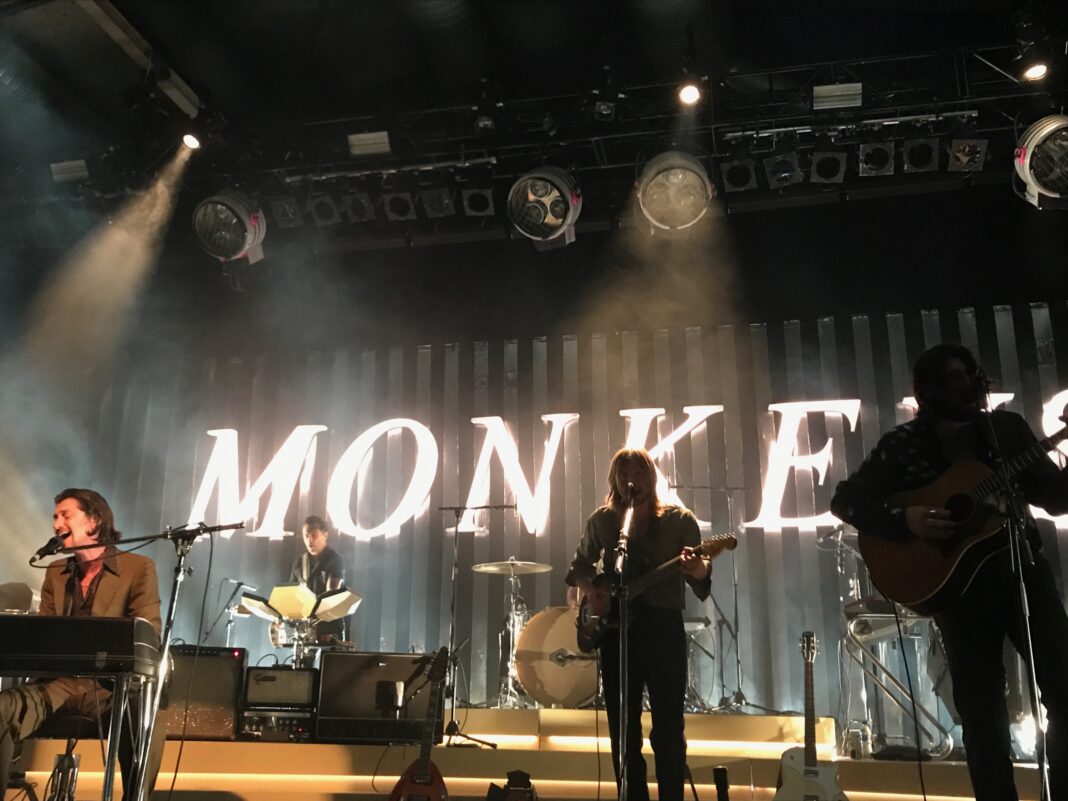‘Impact of Arctic Monkeys’ debut almost impossible to put into words’
Domino Records
Jessica Rickards, then Jessie May Cuffe, was out on the town in Liverpool when she was scouted
Twenty years ago an emerging “blog rock” band from Sheffield released their debut single. Though they had only been signed the year before – and to a small independent label – I Bet You Look Good on the Dancefloor shot straight to number one and stayed in the top 100 for 31 weeks.
Written by frontman Alex Turner, it was described by critics as the perfect encapsulation of what it was to be “young, pissed, lusty, bored, angry and skint” in modern-day Britain.
And at a time when The Strokes, The White Stripes and The Libertines reigned, it was also one of the first singles to be successfully marketed by fans – and the internet.
The Arctic Monkeys were a hungry, young foursome from the working-class suburb of High Green.
PA Media
The band were one of the first to use the internet to promote their music
They gave out free CDs at their gigs which encouraged fans to swap songs online – namely on MySpace – which created a powerful social media-driven buzz.
BBC music correspondent Mark Savage said there was a “huge excitement” around their music before they had even released a single or signed a record deal.
“They would hand out CDs of their demos at gigs and friends of the band would reportedly burn more copies and leave them on local buses.
“There was a huge buzz and it all happened without the help of a record label or traditional press.
“It felt like a proper grassroots movement, which only made it more exciting.”
So before they were even signed or I Bet You Look Good on the Dancefloor was officially released, the Arctic Monkeys were selling out venues like the London Astoria and the Ritz in Manchester.
The single dropped on 17 October 2005 and the cover featured a moody teenage supermarket cashier wearing a tabard.
Jessica Rickards
The Arctic Monkeys were just “shy” teenagers when their first single came out -pictured with Jessica Rickards, the model on the cover
The sullen teenager was 16-year-old Jessie May Cuffe, an unknown schoolgirl who had sneaked out to go drinking with friends in Liverpool when she was photographed by the graphic designer in charge of the album’s artwork.
The band had decided on a “concept” for the single cover, she said, but not the girl.
Now Jessica Rickards, she told the BBC: “I think they wanted someone blonde originally but I wasn’t doing a typical model pose – because I was bladdered.
“So in my picture I was smiling and I just stood out a little bit more I think.”
She also said it was before mobile phones so she gave the photographer her mother’s landline to contact her on.
Ms Rickards did not get paid for her “first and only modelling shoot”, but instead she got tickets to their next gig.
“But when you’re 16, you would rather have that.
“When I met them after the shoot they were about 18 or 19 I think and Alex was really shy.”
Jessica Rickards
Ms Rickards, now 36, works as a civil servant and has a five-year-old son
“I never thought the song would have such a huge legacy.
“To be honest it’s not my favourite Arctic Monkeys song but it’s the one that will get everyone out dancing.”
Ms Rickards added: “I think I knew how big they were going to be when my mum went into HMV just after the single had come out and the whole wall was just my face.”
Ms Rickards, 36, is now a civil servant and lives in the Wirral with her five-year-old son.
She calls herself a “homebody” but still likes going to gigs and admitted the modelling story was a great ice-breaker at “awkward” interviews or even on dates.
“I’m never stuck for something to say.”
Who is the Arctic Monkeys cover girl?
She has not had any contact with the band since soon after the shoot and said she might feel “nervous” to meet them now.
Ms Rickards also said being on the single cover “pulled her out of her shell”.
“I was painfully shy and I wasn’t even sure I would go through with it but my mum told me to”, she said.
“It really boosted my confidence.”
Ms Rickards said she was looking forward to telling her son when he is old enough about how “rock and roll” his mother was.
Hayley Coyle/BBC
The Grapes in Sheffield is where the band held their very first gig
The venue of the Arctic Monkeys’ first ever gig in 2003 was The Grapes in Sheffield.
The band – which then included the original bassist Andy Nicholson – took home just £17 that night and the pub’s landlady said the audience mostly consisted of the band’s “aunts, mums and dads”.
They played in a room above the pub that is now The Grapes owner Ann Flynn’s living quarters and she said Alex Turner, 39, even came back for a secret visit about 10 years ago to just stand there and reflect.
Mrs Flynn said that when underage bands played, the fans were usually too young to drink so she made sure an older act played too – otherwise “you’d not be taking any money”.
Mrs Flynn has owned the pub since 2001 and prior to that, ran the nearby Dog and Partridge for 40 years.
When asked if she could have predicted how big the Arctic Monkeys were going to be, she said: “Someone said to me that night, they’re going to be really, really big.
Hayley Coyle/BBC
The pub has also been the location for a photo shoot for The Killers
“And I said, ‘oh yes, we’ve all heard that before’.
“I had no idea they would become global – and I only like Irish music.”
Mrs Flynn said she would recognise Alex Turner if he came in now “because he’s so handsome”.
“He came in once and told my niece who was working here that he would love to just go upstairs and stand in the room where it all started.
“It was just a store room then and he said he just wanted to walk up there and stand there again,” she said.
Mrs Flynn, 72, called the band “lovely lads” who always remember Sheffield.
“They always say on TV their first gig was at The Grapes and I think that’s very gracious.
“When they played in Hillsborough a few years ago they mentioned us and the pub was absolutely packed,” she added.
Mr Savage said: “The influence of Arctic Monkeys’ debut is almost impossible to put into words. Hundreds of bands – from Catfish and the Bottlemen and Blossoms to The Vaccines and Courteeners – were inspired by Alex Turner and company.
“And because their origin story was so organic and divorced from the machinations of the music industry, their success became a real rallying cry for British guitar bands.”





